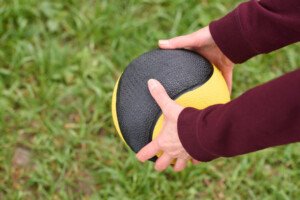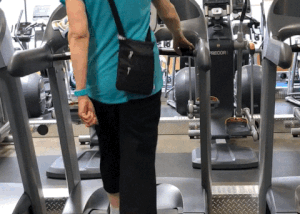How can the 60uP “balance board” improve your balance if you’re holding onto its handles?
60uP Review: If you’ve seen the commercials for 60uP, which is targeted to able-bodied men and women over age 60 whose “balance isn’t what it used to be,” then you know that in every demo scene, the user is holding onto the handles of this device — even when doing single-arm curls!

Will holding onto the handle train your body to pick something heavy up with one hand if the other hand has nothing to grasp?
I was surprised to see that a device, in which the user is grasping handles, is touted for improving balance.
It doesn’t make much sense that the best way to improve balance in an older body with no mobility handicap such as MS is to move your legs around while you’re holding stationary handles for support!
The leg exercises that one can do while holding the handles will result in slight improvement in balance simply because this is movement that the sedentary older user normally wouldn’t be doing.
It’s new to their body, and a training stimulus will result. In fact, one need not be standing while exercising to improve their neuromuscular connections.
This is why strength training the legs while seated (leg extension, leg curl, leg press) will slightly improve one’s balance.

But what would be far better for improving balance and fall prevention are:
- Stationary lunge (holding a hand to a countertop or wall only for transient balance checks with the goal of no longer needing to do this)
- Walking up and down a staircase without holding onto the railings
- Walking on a treadmill without holding on
- Brisk walking on sand
- Stepping up and down on the bottom step of a staircase (holding the rail or wall only for momentary balance checks)
- Yoga and tai chi
So how does the 60uP rank as far as how well it improves balance of older people with no mobility impairment?
Let’s use common sense. If you’re able-bodied (don’t use a cane or walker) and want to improve your balance and prevent falls, why would you do exercises while holding onto handles?

When you, as an able-bodied but older person, move around during the activities of daily living, you’re not holding onto anything for support – save for maybe the railing of a staircase.
The ability to ambulate in free space without the threat of falling is best achieved by performing exercise without holding onto anything for support!
Again, I need to strongly point out that a sedentary person will gain some improvement in balance upon using the 60uP device.
BUT holding onto fixed poles is nowhere near the best way to boost balance.
In fact, it’s quite limited because the very act of grasping those handles contradicts movement in open space.
I can’t ask it enough: How well can exercise equipment improve balance if you’re holding onto it for support?!
After my elderly mother recovered from a hip replacement surgery, I had her do exercises designed for preventing another fall.
Great Exercises for Improving Balance and Fall Prevention
Because the issue is how well you balance in free space, the exercises should be done in free space: NO holding onto anything for support — other than for momentary balance checks.
In the case of my mother, I stood behind her or beside her to “catch her” if she began losing balance.
But she was not holding onto anything for support.
#1 Clock Lunge. Lunge forward (12 o’clock) with your right foot, then back to the start position.
Repeat to the 3 o’clock (to the side) position and return to the start position. Then do 6 o’clock (behind you). Repeat with the left foot (12, then 9, then 6).
#2 Sideways Walk. Walk sideways in both directions several times across the largest room of the house with your hands folded atop your head.
#3 Forward and Back Stepping. Stand facing a low platform such as the one below. With the right foot, step over it, then bring the other foot over.

Then return the right foot to the start position (bringing it backwards over the platform), followed by the left foot.
Work up to 20 times leading with the right foot. Repeat the routine with the left foot.
If you’re too off-balance to do this, then do it without a platform. When this or using a low platform begins feeling easy, hold light hand weights or do it with your hands behind your back.
- Teetering and its subsequent recalculating force the body to improve balance.
- Holding onto handles for support does NOT force the body to improve balance.
- Do shallow front and back lunges, front and side alternating high knees, partial squats, etc., before a countertop or in a hallway between two walls and use those surfaces for momentary checks when teetering.
#4 Toss a child’s big ball up vertically as high as you can without losing control and then catch it with only your hands (don’t catch it against your chest).
You may think this is easy, but for someone over 60 who’s off-balance, this will be challenging.
Catching the ball forces your body to brace and correct for a momentary dissonance in balance. Ideally the ball should be a medicine ball weighing two pounds.
Better yet, have someone toss the ball to you from about seven to eight feet away (no more).
As your recalculation response improves, have your partner toss the ball towards your side (forcing you to mini-lunge) and a little short in front (the partner should not reveal where the ball is going).
Your body will be forced to make very quick recalculations for unpredictable angles.

Depositphotos.com
#5 Walk backwards in a linear path. Make sure the path is clear, such as a clean hallway.
#6 Walk forwards with your feet very close together, as though walking on an imaginary eight-inch-wide strip. This narrows your base of support, forcing the adaptation of better balance.
#7 If you have access to a treadmill, walk a medium pace WITHOUT holding on.
If this is tricky, reduce the speed, then gradually increase over time.

Shutterstock/Dmytro Zinkevych
Able-bodied older people, even “out of shape” ones, should not be using sticks or poles for fitness walking, as these will undermine attempts to improve balance.
All of these suggestions apply to older people who do not need a cane or walker.
Though my mother was elderly and had had a hip replacement, she was able to do all of these exercises. The improvement in her balance and new-found stability in her ambulation was remarkable.
Though the 60uP device with its program is better than nothing, it’s nowhere near the best way to improve balance for seniors who already are walking without the aid of a cane or walker.










































